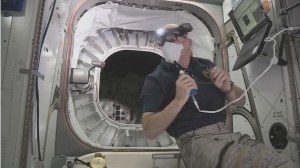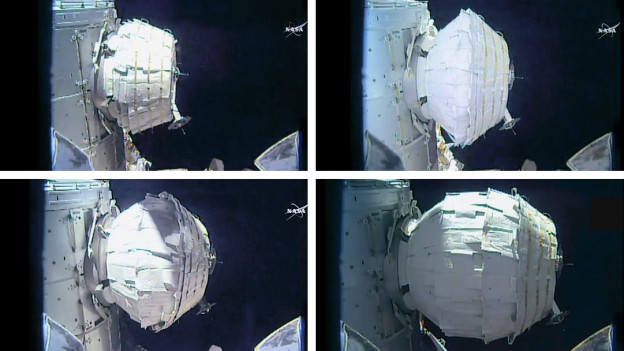This week, astronauts successfully entered the International Space Station’s first inflatable habitat.
Wearing a mask and a headlamp, NASA astronaut Jeff Williams opened the hatch to the Bigelow Expandable Activity Module (BEAM). Williams, joined by Russian cosmonaut, Oleg Skripochka, collected air samples and downloaded data from sensors embedded in the expanded module.
After checking the sensors, temperature, air samples, and condition of the inner surfaces of BEAM, Williams reported that the expanded module was in “pristine condition.”
Once all initial inspections were completed, all crew exited and BEAM’s latch was closed. Space station crewmembers will reenter the module a few more times this week.
BEAM, a product by Bigelow Aerospace, was launched to the ISS on April 8th in the trunk of a SpaceX Dragon capsule. About a week after its arrival, the compacted module was robotically taken from Dragon and attached to Node 3 on the space station.
Expansion of BEAM, however, did not go exactly as planned.
The module was originally scheduled for inflation on May 26th. On that day, Williams opened a valve to allow air from the ISS to gradually inflate and expand the module. Unfortunately, while the air flowed into BEAM, cameras mounted on the outside of the ISS showed that the module was not growing as quickly as it should have been.
After an attempt that lasted two hours, NASA halted the expansion, reporting that the module only grew 5 inches axially when it was designed to expand 68 inches.
“We’ve been assessing all the parameters here from the ground, and due to our set of ‘no go’ conditions and not seeing any noticeable movement, we are going to have to reassess further from here.” – Astronaut Jessica Meir from the ground at Mission Control
Two days after the first failed attempt, NASA tried to expand BEAM a second time and was successful.
Representatives from NASA stated that the original issues were likely related to the “memory” of the BEAM material from its time being compressed. They believed that the fabric of the module required additional time to bounce back to its expanded configuration after being folded up for so long.
Williams expanded the module slowly by opening the air valve 25 different times over the course of seven hours. It was important to inflate BEAM slowly because the time in between the bursts of air allowed the module to stabilize.

NASA Astronaut Jeff Williams floating outside the entrance to the Bigelow Expandable Activity Module (BEAM)
While inflated modules may seem more susceptible to ripping or tearing from impacts from micro-meteoroids or other debris, this is not necessarily the case. Bigelow Aerospace has stated that BEAM can resist high velocity impacts from small particles just as well as rigid alternatives. BEAM was designed to protect from such impacts with multiple layers of soft goods including a bladder and a micro-meteoroids and orbital debris (MMOD) shield.
Expandable habitats like BEAM are new and could be a key technology for future space missions. On space missions where humans are involved, mass and volume are especially limited and expandable habitats are likely to be lighter and smaller than existing alternatives. The fact that they can be compacted for launch and inflated once in outer space offers an attractive option for future crewed missions.
The benefits of expandable habitats certainly sound promising. However, more research needs to be done, and it starts with BEAM.
Bigelow’s module will remain attached to the ISS for two more years to allow NASA to test its durability and inform future expandable habitat designs.
